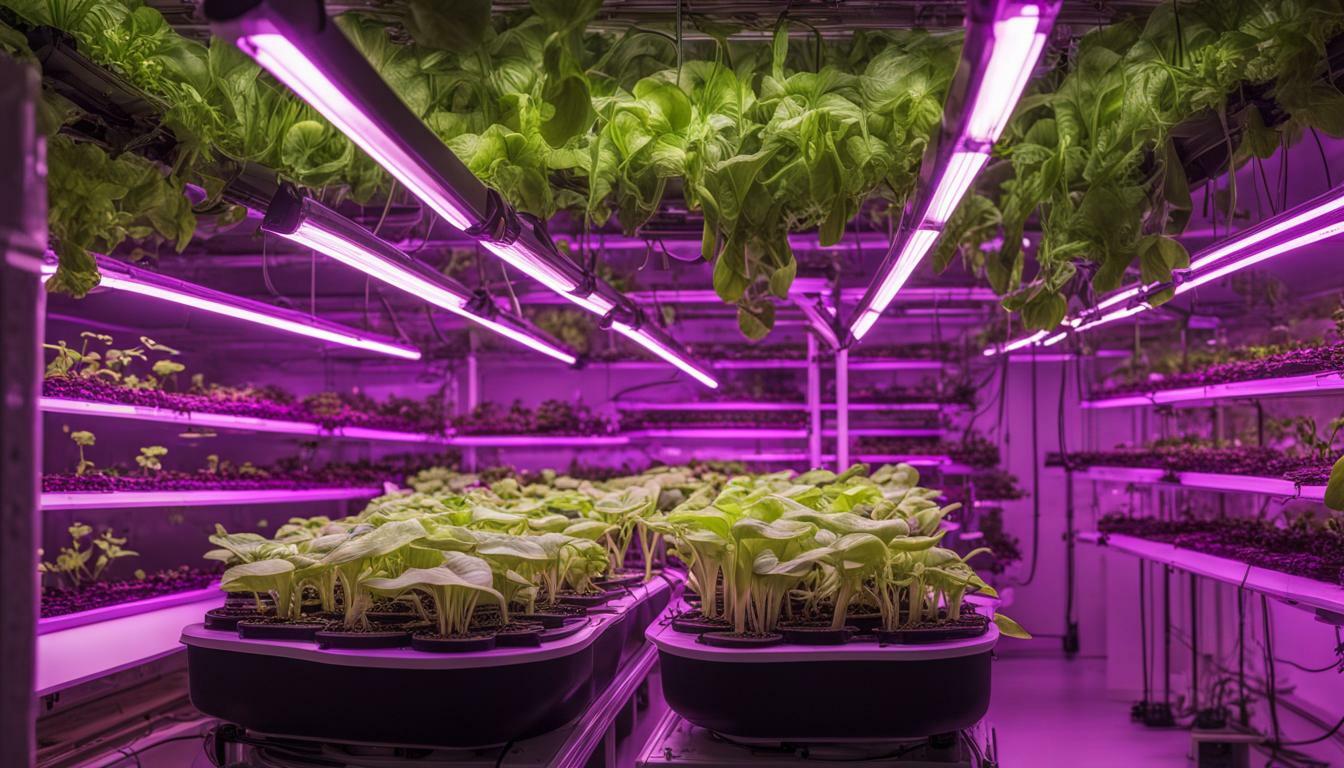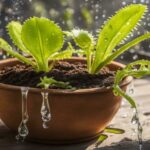Are you curious about growing Venus Flytraps hydroponically? These captivating carnivorous plants have long been a subject of fascination for gardeners and nature enthusiasts alike. But can they be grown without soil? The answer is a resounding yes! In this comprehensive guide, we’ll explore everything you need to know about hydroponic Venus Flytrap cultivation.
Key Takeaways:
- Venus Flytraps can indeed be grown hydroponically, without soil.
- Hydroponic methods and systems offer several advantages over traditional soil-based cultivation.
- To successfully grow Venus Flytraps hydroponically, it’s important to understand their unique features and growing conditions.
- There are multiple hydroponic methods and systems to choose from, each with its own benefits and considerations.
- Expert tips and techniques can enhance the success of your Venus Flytrap hydroponic gardening project.
Understanding Venus Flytraps and Their Growing Conditions
If you’re considering growing Venus Flytraps hydroponically, it’s essential to understand their unique features and the conditions necessary for their healthy growth. Venus Flytraps, native to the bogs and wetlands of the southeastern United States, are fascinating carnivorous plants that capture and digest insects to supplement their nutrient intake.
Venus Flytraps have specialized leaves that can fold together when tiny trigger hairs are stimulated by an insect. Once the trap is closed, digestive enzymes dissolve the prey and release nutrients that the plant can absorb.
When it comes to their growing conditions, Venus Flytraps require a specific set of environmental factors to thrive in both soil and hydroponic systems. These include:
- Bright, direct sunlight for at least 4-6 hours per day
- Air temperatures between 70-85°F during the day and 50-60°F at night
- High humidity levels between 50-70%
- A soil (or hydroponic) medium that is low in nutrients and acidic, with a pH between 4.5-5.5
- Distilled or reverse osmosis water for hydration, as tap water often contains minerals and salts that can harm the plants
By ensuring that your Venus Flytraps have access to these conditions, you can provide them with the optimal foundation for healthy growth, whether they are grown in soil or hydroponically.
Hydroponic Methods for Growing Venus Flytraps
Hydroponic systems offer a soil-free alternative for growing Venus Flytraps. By eliminating the need for soil, hydroponics can provide optimal growing conditions for these carnivorous plants and ensure efficient nutrient uptake. Let’s explore some of the most popular hydroponic methods for growing Venus Flytraps without soil:
Water Culture Method
The water culture method is one of the simplest hydroponic methods and involves placing the Venus Flytrap’s roots directly in water. This method allows for a high level of aeration and adequate nutrient uptake, making it an effective method for Venus Flytrap cultivation. However, it requires regular monitoring of pH levels and can be challenging for novice growers.
Nutrient Film Technique (NFT)
The nutrient film technique involves growing plants in a shallow stream of nutrient-rich water. This method provides constant access to nutrients, oxygen, and water, making it an efficient way to grow Venus Flytraps. However, it requires careful monitoring of nutrient levels and pH levels to ensure optimal plant health.
Deep Water Culture (DWC)
The deep water culture method involves suspending the Venus Flytrap’s roots in a nutrient-rich solution and providing constant aeration through an air pump. This method eliminates the need for frequent watering and can produce excellent growth rates. However, it requires consistent monitoring of pH levels and can be challenging to maintain in hot weather.
Aeroponics
Aeroponics involves growing plants in a mist or aerosol of nutrient-rich water. This method provides excellent oxygenation to the plant roots and efficient nutrient uptake, making it a highly effective method for Venus Flytrap cultivation. However, it requires specialized equipment and technical knowledge, making it more suitable for experienced growers.
Choosing Your Hydroponic Method
Each of these hydroponic methods has its advantages and potential challenges. When selecting a hydroponic method for your Venus Flytraps, consider your experience level, available resources, and the specific needs of your plants. With the right method and careful attention, you can successfully grow Venus Flytraps without soil and enjoy the benefits of hydroponic cultivation.
Hydroponic Systems for Venus Flytraps
When it comes to growing Venus Flytraps in a hydroponic system, choosing the right equipment is crucial. The system you select will have a significant impact on the growth rate and overall health of your plants. Here are some hydroponic systems suitable for Venus Flytraps:
| Hydroponic System | Description | Advantages |
|---|---|---|
| Drip Irrigation System | An irrigation system that delivers a nutrient solution to each plant through a series of tubes. | Allows for precise control over nutrient and water delivery, reducing the risk of over or under watering. Also saves water and nutrients by delivering them directly to the plant. |
| Ebb and Flow System | A system where the plants are periodically flooded with a nutrient solution and then drained. | Provides a consistent flow of nutrients to the plants, reducing the risk of nutrient deficiencies. Also helps to reduce the risk of root rot by allowing the roots to dry out between watering. |
| Nutrient Film Technique (NFT) | A system that continuously flows a thin film of nutrient solution over the roots of the plants. | Allows for a constant flow of nutrients to the plant roots, promoting healthy growth. Also saves water and nutrients. |
When selecting a hydroponic system for your Venus Flytraps, consider factors such as space, cost, and ease of use. Remember that each system has its own advantages and drawbacks. It’s important to research and understand the features of each system to choose the one that suits your needs best.
Advantages of Growing Venus Flytraps Hydroponically
Hydroponic venus flytrap cultivation has several benefits over traditional soil-based methods. Here are some advantages:
- Enhanced Nutrient Uptake: Hydroponic systems provide a highly controlled environment where the exact nutrients needed for optimal plant growth can be supplied directly to the roots. This results in better nutrient uptake and faster plant growth.
- Controlled pH Levels: Soil-based methods often have fluctuating pH levels that can be detrimental to plant growth. Hydroponic systems allow for a more precise regulation of pH levels, ensuring that the plants receive the ideal conditions for growth.
- Efficient Use of Water: Hydroponic systems use up to 90% less water than conventional soil-based methods, making them a more environmentally friendly option. The water is also recirculated, reducing waste.
- Economical use of Space: Hydroponic systems take up less space than traditional soil-based methods. This is because plants grown hydroponically have smaller root systems, allowing for more plants to be grown in a smaller area.
- Reduced Risk of Soil-borne Pests and Diseases: Hydroponic systems eliminate the need for soil, reducing the risk of soil-borne pests and diseases that can plague traditional soil-based methods.
Overall, hydroponic venus flytrap cultivation offers a more efficient and effective way to grow these unique and captivating plants. By creating an optimal hydroponic environment, you can ensure healthy growth and maximize the benefits of this innovative approach to gardening.
Tips for Successful Hydroponic Venus Flytrap Cultivation
Hydroponic cultivation of Venus Flytraps can be a challenging but rewarding experience. To ensure your plants’ healthy growth, keep in mind the following expert tips:
- Choose the right growing medium: Unlike traditional soil-based cultivation, Venus Flytraps need a growing medium that retains moisture while allowing roots to breathe. Suitable options include sphagnum moss, vermiculite, or perlite. Avoid clay pellets or granular media, as they can damage sensitive roots and trigger root rot.
- Maintain proper nutrient levels: Venus Flytraps require specific nutrients, such as nitrogen, phosphorus, and potassium, in precise amounts. Consider using a specialized hydroponic nutrient solution formulated for carnivorous plants, or create your own using distilled water and all-purpose fertilizer, diluted to one-quarter strength. Monitor the pH level regularly to ensure it remains between 4.5 and 5.5.
- Control humidity and temperature: Venus Flytraps prefer high humidity levels between 70-80%, combined with temperatures between 65-75°F during the day and 50-60°F at night. Consider using a humidifier or a pebble tray to maintain moisture levels, and avoid exposing your plants to direct sunlight or drafts.
- Ensure proper lighting: Venus Flytraps require bright light, equivalent to about 6-8 hours of direct sunlight per day. Consider using a full-spectrum LED grow light or a high-intensity discharge (HID) lamp, placed 6-12 inches above your plants. Avoid using fluorescent bulbs, as they emit weak light that can stunt growth.
- Minimize handling and disturbance: Venus Flytraps are delicate plants that can easily get stressed or damaged if handled or disturbed too often. Avoid touching the leaves or traps, and only water your plants from the bottom to prevent splashing on the foliage. Additionally, remove any dead or decaying leaves promptly to prevent bacterial or fungal infections.
By following these tips, you’ll be able to provide optimal hydroponic conditions for your Venus Flytraps and enjoy their unique beauty and carnivorous behavior.
Conclusion
Growing Venus Flytraps hydroponically provides a unique and exciting way to cultivate these fascinating carnivorous plants. By understanding their specific growing conditions and selecting the right hydroponic methods and systems, you can create an optimal environment for nurturing healthy Venus Flytraps without traditional soil.
In this guide, we’ve explored the various hydroponic techniques and systems available for growing Venus Flytraps, as well as the advantages they offer over soil-based cultivation. We’ve also provided expert tips and techniques for ensuring the successful growth of your hydroponic Venus Flytraps.
Now that you have a solid foundation of knowledge on hydroponic Venus Flytrap cultivation, it’s time to embark on your own exciting venus flytrap hydroponic gardening project. With careful attention to the specific factors and expert guidance provided in this guide, you can enjoy the rewards of growing healthy and thriving Venus Flytraps without soil. Start your hydroponic adventure today!
What Are the Steps to Successfully Grow Venus Flytraps in Terrariums?
To successfully grow Venus Flytraps in terrariums, follow these steps. Firstly, choose a terrarium with good drainage and ventilation. Next, create a suitable growing medium using a mix of sphagnum moss and sand. Then, place the terrarium in a spot with ample sunlight or use artificial lights for sufficient exposure. Remember to keep the humidity levels high, between 60-70%. Lastly, water the plants with distilled water or rainwater, ensuring the soil stays consistently moist, but not wet. By employing these measures, you can optimize the conditions for growing venus flytraps in terrariums.
FAQ
Q: Can Venus Flytraps be grown hydroponically?
A: Yes, Venus Flytraps can be grown hydroponically using specialized systems and methods.
Q: What are the advantages of hydroponic Venus Flytrap cultivation?
A: Hydroponic cultivation offers benefits such as enhanced nutrient uptake, controlled pH levels, efficient use of water and space, and reduced risk of soil-borne pests and diseases.
Q: What are the hydroponic methods for growing Venus Flytraps?
A: There are various hydroponic methods available for growing Venus Flytraps, including the water culture method, nutrient film technique (NFT), and deep water culture (DWC).
Q: What hydroponic systems are suitable for Venus Flytraps?
A: Different hydroponic systems, such as drip irrigation systems and ebb and flow systems, can be used for growing Venus Flytraps. Each system has its own features, benefits, and considerations.
Q: What are some tips for successful hydroponic Venus Flytrap cultivation?
A: To ensure successful hydroponic Venus Flytrap cultivation, it is important to choose the right growing medium, maintain proper nutrient levels and humidity, and provide the necessary care and attention to the plants.











